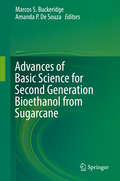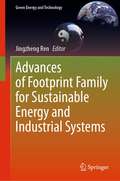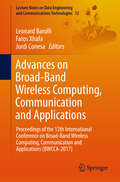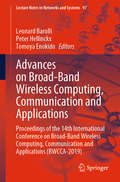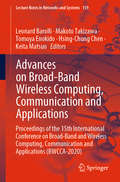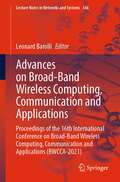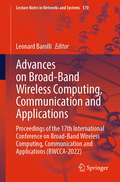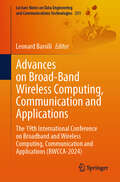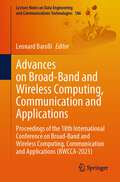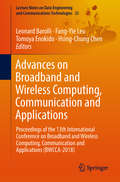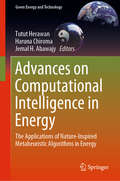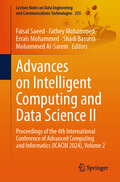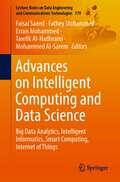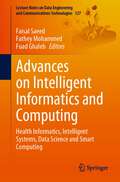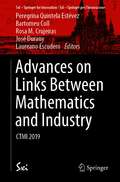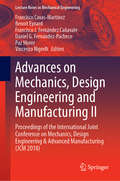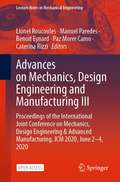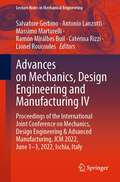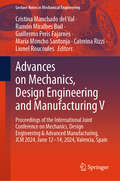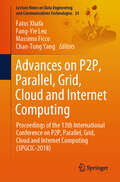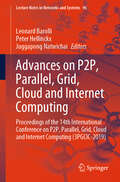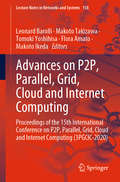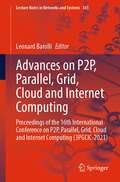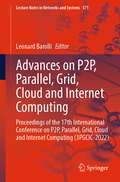- Table View
- List View
Advances of Basic Science for Second Generation Bioethanol from Sugarcane: Bioethanol From Sugarcane And Their Impact On Technology
by Marcos S. Buckeridge Amanda P. De SouzaThis book focuses on the basic science recently produced in Brazil for the improvement of sugarcane as a bioenergy crop and as a raw material for 2nd generation bioethanol production. Part I details the development of some of the most important basic scientific tools needed for 2nd generation technologies of sugarcane in the domains of plant physiology and agricultural sciences and the domains of chemistry and biochemistry of plants and microorganisms. These include issues such as plant cell wall structure and architecture, physical characteristics of sugarcane biomass that are to be used for hydrolysis and fermentation in 2nd generation processes. Part II focuses on the development of the more applied sciences necessary to advance technological processes of pretreatment and hydrolysis of biomass and fermentation of the free sugars released from it. Some aspects of enzyme engineering are approached in this session and ends with a proposition of the assembly of an enzymatic cocktail based on the discoveries made by INCT-Bioethanol researchers after discovery of new enzymes among the Brazilian biodiversity of microorganisms. Part III examines the issue of how some key elements of basic science (Part I) have be applied to develop technologies for 2nd generation bioethanol (Part II). The translation from basic to applied sciences is highlighted as key for innovation using examples based on recent case studies in the area. In Part IV, a discussion about how policies that interconnect the scientific communities among scientists and the society in general of countries can help to accelerate or decelerate technological development depending on how efficient is communication among scientists, policy makers and industry.
Advances of Footprint Family for Sustainable Energy and Industrial Systems (Green Energy and Technology)
by Jingzheng RenThis book presents various methodologies for determining the ecological footprint, carbon footprint, water footprint, nitrogen footprint, and life cycle environment impacts and illustrates these methodologies through various applications. In particular, it systematically and comprehensively introduces the concepts and tools of the ‘footprint family’ and discusses their applications in energy and industrial systems. The book begins by providing an overview of the effects of the economic growth dynamics on ecological footprint and then presents the definitions, concepts, calculation methods, and applications of the various footprints. The unique characteristic of this book is that it demonstrates the applications of various footprints in different systems including economic system, ecological system, beef production system, cropping system, building, food chain, sugarcane bioproducts, and the Belt and Road Initiative. Providing both background theory and practical advice, the book is of interest to energy and environmental researchers, graduate students, and engineers.
Advances on Broad-Band Wireless Computing, Communication and Applications: Proceedings of the 12th International Conference on Broad-Band Wireless Computing, Communication and Applications (BWCCA-2017) (Lecture Notes on Data Engineering and Communications Technologies #12)
by Fatos Xhafa Leonard Barolli Jordi ConesaThis book gathers the Proceedings of the 12th International Conference on Broad-Band Wireless Computing, Communication and Applications, held on November 8-10, 2017 in Barcelona, Spain. Information networking is currently undergoing a rapid evolution. Different kinds of networks with different characteristics are emerging and being integrated in heterogeneous networks. As a result, there are many interconnected problems that can occur at different levels of the hardware and software design of communicating entities and communication networks. These networks are expected to manage increasing usage demand, provide support for a significant number of services, guarantee Quality of Service (QoS), and optimize the use of network resources. The success of all-IP networking and wireless technology has changed the lifestyles of people around the world, and advances in electronic integration and wireless communications will pave the way to providing access to wireless networks on the fly, as electronic devices can increasingly exchange information with each other virtually anytime and anywhere. The aim of this book is to provide the latest findings, methods and development techniques from both theoretical and practical perspectives regarding the emerging areas of broad-band and wireless computing.
Advances on Broad-Band Wireless Computing, Communication and Applications: Proceedings of the 14th International Conference on Broad-Band Wireless Computing, Communication and Applications (BWCCA-2019) (Lecture Notes on Data Engineering and Communications Technologies #97)
by Leonard Barolli Tomoya Enokido Peter HellinckxThis proceedings book presents the latest research findings, innovative research results, methods and development techniques related to the emerging areas of broadband and wireless computing, from both theoretical and practical perspectives. Today’s information networks are going through a rapid evolution. Different kinds of networks with different characteristics are emerging, and are being integrated into heterogeneous networks. As a result, there are numerous interconnection problems that can occur at different levels of the hardware and software design of communicating entities and communication networks. Such networks need to manage an increasing usage demand, provide support for a significant number of services, guarantee their QoS, and optimize the network resources. The success of all-IP networking and wireless technology has changed the way of living for people around the globe. Advances in electronic integration and wireless communications will pave the way to offering access to wireless networks on the fly, which in turn will allow electronic devices to share information with each other wherever and whenever necessary.
Advances on Broad-Band Wireless Computing, Communication and Applications: Proceedings of the 15th International Conference on Broad-Band and Wireless Computing, Communication and Applications (BWCCA-2020) (Lecture Notes in Networks and Systems #159)
by Makoto Takizawa Leonard Barolli Tomoya Enokido Hsing-Chung Chen Keita MatsuoThis book aims to provide the latest research findings, innovative research results, methods and development techniques from both theoretical and practical perspectives related to the emerging areas of broadband and wireless computing. Information networks of today are going through a rapid evolution. Different kinds of networks with different characteristics are emerging, and they are integrating in heterogeneous networks. For these reasons, there are many interconnection problems which may occur at different levels of the hardware and software design of communicating entities and communication networks. These kinds of networks need to manage an increasing usage demand, provide support for a significant number of services, guarantee their QoS, and optimize the network resources. The success of all-IP networking and wireless technology has changed the ways of living the people around the world. The progress of electronic integration and wireless communications is going to pave the way to offer people the access to the wireless networks on the fly, based on which all electronic devices will be able to exchange the information with each other in ubiquitous way whenever necessary.
Advances on Broad-Band Wireless Computing, Communication and Applications: Proceedings of the 16th International Conference on Broad-Band Wireless Computing, Communication and Applications (BWCCA-2021) (Lecture Notes in Networks and Systems #346)
by Leonard BarolliThis book states that information networks of today are going through a rapid evolution. Different kinds of networks with different characteristics are emerging and they are integrating in heterogeneous networks. For these reasons, there are many interconnection problems which may occur at different levels of the hardware and software design of communicating entities and communication networks. These kinds of networks need to manage an increasing usage demand, provide support for a significant number of services, guarantee their QoS, and optimize the network resources. The success of all-IP networking and wireless technology has changed the ways of living the people around the world. The progress of electronic integration and wireless communications is going to pave the way to offer people the access to the wireless networks on the fly, based on which all electronic devices will be able to exchange the information with each other in ubiquitous way whenever necessary.The aim of the book is to provide latest research findings, innovative research results, methods, and development techniques from both theoretical and practical perspectives related to the emerging areas of broad-band and wireless computing.
Advances on Broad-Band Wireless Computing, Communication and Applications: Proceedings of the 17th International Conference on Broad-Band Wireless Computing, Communication and Applications (BWCCA-2022) (Lecture Notes in Networks and Systems #570)
by Leonard BarolliThis book aims to provide latest research findings, innovative research results, methods, and development techniques from both theoretical and practical perspectives related to the emerging areas of broadband and wireless computing. Information networks of today are going through a rapid evolution. Different kinds of networks with different characteristics are emerging, and they are integrating in heterogeneous networks. For these reasons, there are many interconnection problems which may occur at different levels of the hardware and software design of communicating entities and communication networks. These kinds of networks need to manage an increasing usage demand, provide support for a significant number of services, guarantee their QoS, and optimize the network resources. The success of all-IP networking and wireless technology has changed the ways of living the people around the world. The progress of electronic integration and wireless communications is going to pave the way to offer people the access to the wireless networks on the fly, based on which all electronic devices will be able to exchange the information with each other in ubiquitous way whenever necessary.
Advances on Broad-Band Wireless Computing, Communication and Applications: The 19th International Conference on Broadband and Wireless Computing, Communication and Applications (BWCCA-2024) (Lecture Notes on Data Engineering and Communications Technologies #231)
by Leonard BarolliThis book aims to provide latest research findings, innovative research results, methods, and development techniques from both theoretical and practical perspectives related to the emerging areas of broadband and wireless computing. Information networks of today are going through a rapid evolution. Different kinds of networks with different characteristics are emerging and they are integrating in heterogeneous networks. For these reasons, there are many interconnection problems which may occur at different levels of the hardware and software design of communicating entities and communication networks. These kinds of networks need to manage an increasing usage demand, provide support for a significant number of services, guarantee their QoS, and optimize the network resources. The success of all-IP networking and wireless technology has changed the ways of living the people around the world. The progress of electronic integration and wireless communications is going to pave the way to offer people the access to the wireless networks on the fly, based on which all electronic devices will be able to exchange the information with each other in ubiquitous way whenever necessary.
Advances on Broad-Band and Wireless Computing, Communication and Applications: Proceedings of the 18th International Conference on Broad-Band and Wireless Computing, Communication and Applications (BWCCA-2023) (Lecture Notes on Data Engineering and Communications Technologies #186)
by Leonard BarolliThe aim of this book is to provide latest research findings, innovative research results, methods, and development techniques from both theoretical and practical perspectives related to the emerging areas of broad-band and wireless computing. Information networks of today are going through a rapid evolution. Different kinds of networks with different characteristics are emerging and they are integrating in heterogeneous networks. For these reasons, there are many interconnection problems which may occur at different levels of the hardware and software design of communicating entities and communication networks. These kinds of networks need to manage an increasing usage demand, provide support for a significant number of services, guarantee their QoS, and optimize the network resources. The success of all-IP networking and wireless technology has changed the ways of living the people around the world. The progress of electronic integration and wireless communications is going to pave the way to offer people the access to the wireless networks on the fly, based on which all electronic devices will be able to exchange the information with each other in ubiquitous way whenever necessary.
Advances on Broadband and Wireless Computing, Communication and Applications: Proceedings of the 13th International Conference on Broadband and Wireless Computing, Communication and Applications (BWCCA-2018) (Lecture Notes on Data Engineering and Communications Technologies #25)
by Leonard Barolli Tomoya Enokido Fang-Yie Leu Hsing-Chung ChenThis book presents on the latest research findings, and innovative research methods and development techniques related to the emerging areas of broadband and wireless computing from both theoretical and practical perspectives.Information networking is evolving rapidly with various kinds of networks with different characteristics emerging and being integrated into heterogeneous networks. As a result, a number of interconnection problems can occur at different levels of the communicating entities and communication networks’ hardware and software design. These networks need to manage an increasing usage demand, provide support for a significant number of services, guarantee their QoS, and optimize the network resources. The success of all-IP networking and wireless technology has changed the way of life for people around the world, and the advances in electronic integration and wireless communications will pave the way for access to the wireless networks on the fly. This in turn means that all electronic devices will be able to exchange the information with each other in a ubiquitous way whenever necessary.
Advances on Computational Intelligence in Energy: The Applications of Nature-Inspired Metaheuristic Algorithms in Energy (Green Energy and Technology)
by Jemal H. Abawajy Tutut Herawan Haruna ChiromaAddressing the applications of computational intelligence algorithms in energy, this book presents a systematic procedure that illustrates the practical steps required for applying bio-inspired, meta-heuristic algorithms in energy, such as the prediction of oil consumption and other energy products. Contributions include research findings, projects, surveying work and industrial experiences that describe significant advances in the applications of computational intelligence algorithms in energy. For easy understanding, the text provides practical simulation results, convergence and learning curves as well as illustrations and tables. Providing a valuable resource for undergraduate and postgraduate students alike, it is also intended for researchers in the fields of computational intelligence and energy.
Advances on Intelligent Computing and Data Science II: Proceedings of the 4th International Conference of Advanced Computing and Informatics (ICACIN 2024), Volume 2 (Lecture Notes on Data Engineering and Communications Technologies #255)
by Faisal Saeed Fathey Mohammed Errais Mohammed Mohammed Al-Sarem Shadi BasurraThis book presents the proceedings of the 4th International Conference on Advanced Computing and Informatics (ICACIn&’24). The conference, held on December 16–17, 2024, at STEAMhouse, Birmingham City University (UK), with a parallel session at Hassan II University (Morocco), attracted submissions by researchers in 20 countries. Out of 91 submissions, 46 high-quality papers were selected, presenting the latest advancements and cutting-edge developments in computing and informatics. The book covers a wide range of advanced computing topics, including data science, big data analytics, the Internet of Things (IoT), smart computing, artificial intelligence, machine learning, cybersecurity, intelligent communication systems, health informatics, and information systems. Designed for researchers, practitioners, and graduate students, this book serves as a valuable resource for exploring advanced intelligent computing techniques and their real-world applications.
Advances on Intelligent Computing and Data Science: Big Data Analytics, Intelligent Informatics, Smart Computing, Internet of Things (Lecture Notes on Data Engineering and Communications Technologies #179)
by Faisal Saeed Fathey Mohammed Tawfik Al-Hadhrami Errais Mohammed Mohammed Al-SaremThis book presents the papers included in the proceedings of the 3rd International Conference of Advanced Computing and Informatics (ICACin’22) that was held in Casablanca, Morocco, on October 15–16, 2022. A total of 98 papers were submitted to the conference, but only 60 papers were accepted and published in this book with an acceptance rate of 61%. The book presents several hot research topics which include artificial intelligence and data science, big data analytics, Internet of Things (IoT) and smart cities, information security, cloud computing and networking, and computational informatics.
Advances on Intelligent Informatics and Computing: Health Informatics, Intelligent Systems, Data Science and Smart Computing (Lecture Notes on Data Engineering and Communications Technologies #127)
by Faisal Saeed Fathey Mohammed Fuad GhalebThis book presents emerging trends in intelligent computing and informatics. This book presents the papers included in the proceedings of the 6th International Conference of Reliable Information and Communication Technology 2021 (IRICT 2021) that was held virtually, on Dec. 22-23, 2021. The main theme of the book is “Advances on Intelligent Informatics and Computing”. A total of 87 papers were submitted to the conference, but only 66 papers were accepted and published in this book. The book presents several hot research topics which include health informatics, artificial intelligence, soft computing, data science, big data analytics, Internet of Things (IoT), intelligent communication systems, cybersecurity, and information systems.
Advances on Links Between Mathematics and Industry: CTMI 2019 (SxI - Springer for Innovation / SxI - Springer per l'Innovazione #15)
by Peregrina Quintela Estévez Bartomeu Coll Rosa M. Crujeiras José Durany Laureano EscuderoThis book results from the talks presented at the First Conference on Transfer between Mathematics & Industry (CTMI 2019). Its goal is to promote and disseminate the mathematical tools for Statistics & Big Data, MSO (Modeling, Simulation and Optimization) and their industrial applications. In this volume, the reader will find innovative advances in the automotive, energy, railway, logistics, and materials sectors. In addition, Advances CTMI 2019 promotes the opening of new research lines aiming to provide suitable solutions for the industrial and societal challenges. Fostering effective interaction between Academia and Industry is our main purpose with this book. CTMI conferences are one of the main forums where significant advances in industrial mathematics are presented, bringing together outstanding leaders from business, science and Academia to promote the use of mathematics for an innovative industry.
Advances on Mechanics, Design Engineering and Manufacturing II: Proceedings of the International Joint Conference on Mechanics, Design Engineering & Advanced Manufacturing (JCM 2018) (Lecture Notes in Mechanical Engineering)
by Benoit Eynard Vincenzo Nigrelli Francisco Cavas-Martínez Francisco J. Fernández Cañavate Daniel G. Fernández-Pacheco Paz MorerThis book contains the papers presented at the International Joint Conference on Mechanics, Design Engineering and Advanced Manufacturing (JCM 2018), held on 20-22 June 2018 in Cartagena, Spain. It reports on cutting-edge topics in product design and manufacturing, such as industrial methods for integrated product and process design; innovative design; and computer-aided design. Further topics covered include virtual simulation and reverse engineering; additive manufacturing; product manufacturing; engineering methods in medicine and education; representation techniques; and nautical, aeronautics and aerospace design and modeling. The book is divided into six main sections, reflecting the focus and primary themes of the conference. The contributions presented here will not only provide researchers, engineers and experts in a range of industrial engineering subfields with extensive information to support their daily work; they are also intended to stimulate new research directions, advanced applications of the methods discussed, and future interdisciplinary collaborations.
Advances on Mechanics, Design Engineering and Manufacturing III: Proceedings of the International Joint Conference on Mechanics, Design Engineering & Advanced Manufacturing, JCM 2020, June 2-4, 2020 (Lecture Notes in Mechanical Engineering)
by Caterina Rizzi Benoit Eynard Manuel Paredes Paz Morer Camo Lionel RoucoulesThis open access book gathers contributions presented at the International Joint Conference on Mechanics, Design Engineering and Advanced Manufacturing (JCM 2020), held as a web conference on June 2–4, 2020. It reports on cutting-edge topics in product design and manufacturing, such as industrial methods for integrated product and process design; innovative design; and computer-aided design. Further topics covered include virtual simulation and reverse engineering; additive manufacturing; product manufacturing; engineering methods in medicine and education; representation techniques; and nautical, aeronautics and aerospace design and modeling. The book is organized into four main parts, reflecting the focus and primary themes of the conference. The contributions presented here not only provide researchers, engineers and experts in a range of industrial engineering subfields with extensive information to support their daily work; they are also intended to stimulate new research directions, advanced applications of the methods discussed and future interdisciplinary collaborations.
Advances on Mechanics, Design Engineering and Manufacturing IV: Proceedings of the International Joint Conference on Mechanics, Design Engineering & Advanced Manufacturing, JCM 2022, June 1-3, 2022, Ischia, Italy (Lecture Notes in Mechanical Engineering)
by Caterina Rizzi Lionel Roucoules Salvatore Gerbino Antonio Lanzotti Massimo Martorelli Ramón Mirálbes BuilThis book gathers contributions presented at the International Joint Conference on Mechanics, Design Engineering and Advanced Manufacturing (JCM 2022), held on June 1–3, 2022, in Ischia, Italy. It reports on cutting-edge topics in product design and manufacturing, such as industrial methods for integrated product and process design; innovative design; and computer-aided design. Further topics covered include virtual simulation and reverse engineering; additive manufacturing; product manufacturing; engineering methods in medicine and education; representation techniques; and collaborative and soft robotics. The book is organized into five main parts, reflecting the focus and primary themes of the conference. The contributions presented here not only provide researchers, engineers and experts in a range of industrial engineering subfields with extensive information to support their daily work; they are also intended to stimulate new research directions, advanced applications of the methods discussed and future interdisciplinary collaborations.
Advances on Mechanics, Design Engineering and Manufacturing V: Proceedings of the International Joint Conference on Mechanics, Design Engineering & Advanced Manufacturing, JCM 2024, June 12–14, 2024, Valencia, Spain (Lecture Notes in Mechanical Engineering)
by Caterina Rizzi Lionel Roucoules Cristina Manchado del Val Ramón Miralbes Buil Guillermo Peris Fajarnés María Moncho SantonjaThis book contains the papers presented at the International Joint Conference on Mechanics, Design Engineering & Advanced Manufacturing, JCM 2024, held on 12-14 June in Valencia, Spain. It reports on cutting-edge topics in product design and manufacturing, such as industrial methods for integrated product and process design; innovative design; and computer-aided design. Further topics covered include virtual simulation and reverse engineering; additive manufacturing; product manufacturing; engineering methods in medicine and education; representation techniques; and nautical, engineering and construction, aeronautics and aerospace design and modeling. The book is divided into six main sections, reflecting the focus and primary themes of the conference. The contributions presented in this book will not only provide researchers, engineers and experts in a range of industrial engineering subfields with extensive information to support their daily work; but also stimulate new research directions, advanced applications of the methods discussed, and future interdisciplinary collaborations.
Advances on P2P, Parallel, Grid, Cloud and Internet Computing: Proceedings of the 13th International Conference on P2P, Parallel, Grid, Cloud and Internet Computing (3PGCIC-2018) (Lecture Notes on Data Engineering and Communications Technologies #24)
by Fatos Xhafa Fang-Yie Leu Massimo Ficco Chao-Tung YangThis book presents the latest research findings, as well as innovative theoretical and practical research results, methods and development techniques related to P2P, grid, cloud and Internet computing. It also reveals the synergies among such large scale computing paradigms. P2P, Grid, Cloud and Internet computing technologies have rapidly become established as breakthrough paradigms for solving complex problems by enabling aggregation and sharing of an increasing variety of distributed computational resources on a large scale. Grid computing originated as a paradigm for high-performance computing, offering an alternative to expensive supercomputers through different forms of large-scale distributed computing. P2P computing emerged as a new paradigm following on from client-server and web-based computing and has proved useful in the development of social networking, B2B (Business to Business), B2C (Business to Consumer), B2G (Business to Government), and B2E (Business to Employee). Cloud computing has been described as a “computing paradigm where the boundaries of computing are determined by economic rationale rather than technical limits”. Cloud computing has fast become the computing paradigm with applicability and adoption in all domains and providing utility computing at large scale. Lastly, Internet computing is the basis of any large-scale distributed computing paradigm; it has very quickly developed into a vast and flourishing field with enormous impact on today’s information societies and serving as a universal platform comprising a large variety of computing forms such as grid, P2P, cloud and mobile computing.
Advances on P2P, Parallel, Grid, Cloud and Internet Computing: Proceedings of the 14th International Conference on P2P, Parallel, Grid, Cloud and Internet Computing (3PGCIC-2019) (Lecture Notes in Networks and Systems #96)
by Leonard Barolli Juggapong Natwichai Peter HellinckxThis book presents the latest research findings, innovative research results, methods and development techniques related to P2P, grid, cloud and Internet computing from both theoretical and practical perspectives. It also reveals the synergies among such large-scale computing paradigms. P2P, grid, cloud and Internet computing technologies have rapidly become established as breakthrough paradigms for solving complex problems by enabling aggregation and sharing of an increasing variety of distributed computational resources at large scale.Grid computing originated as a paradigm for high-performance computing, as an alternative to expensive supercomputers through different forms of large-scale distributed computing. P2P computing emerged as a new paradigm after client–server and web-based computing and has proved useful in the development of social networking, B2B (business to business), B2C (business to consumer), B2G (business to government), and B2E (business to employee). Cloud computing has been defined as a “computing paradigm where the boundaries of computing are determined by economic rationale rather than technical limits,” and it has fast become a computing paradigm with applicability and adoption in all application domains and which provides utility computing at a large scale. Lastly, Internet computing is the basis of any large-scale distributed computing paradigms; it has developed into a vast area of flourishing fields with enormous impact on today’s information societies, and serving as a universal platform comprising a large variety of computing forms such as grid, P2P, cloud and mobile computing.
Advances on P2P, Parallel, Grid, Cloud and Internet Computing: Proceedings of the 15th International Conference on P2P, Parallel, Grid, Cloud and Internet Computing (3PGCIC-2020) (Lecture Notes in Networks and Systems #158)
by Makoto Takizawa Leonard Barolli Makoto Ikeda Flora Amato Tomoki YoshihisaThis book aims to provide the latest research findings, innovative research results, methods and development techniques from both theoretical and practical perspectives related to P2P, Grid, Cloud and Internet computing as well as to reveal synergies among such large-scale computing paradigms. P2P, Grid, Cloud and Internet computing technologies have been very fast established as breakthrough paradigms for solving complex problems by enabling aggregation and sharing of an increasing variety of distributed computational resources at large scale. Grid Computing originated as a paradigm for high-performance computing, as an alternative to expensive supercomputers through different forms of large-scale distributed computing. P2P Computing emerged as a new paradigm after client–server and web-based computing and has shown useful to the development of social networking, B2B (Business to Business), B2C (Business to Consumer), B2G (Business to Government), B2E (Business to Employee), and so on. Cloud Computing has been defined as a “computing paradigm where the boundaries of computing are determined by economic rationale rather than technical limits”. Cloud computing has fast become the computing paradigm with applicability and adoption in all application domains and providing utility computing at large scale. Finally, Internet Computing is the basis of any large-scale distributed computing paradigms; it has very fast developed into a vast area of flourishing field with enormous impact on today’s information societies serving thus as a universal platform comprising a large variety of computing forms such as Grid, P2P, Cloud and Mobile computing.
Advances on P2P, Parallel, Grid, Cloud and Internet Computing: Proceedings of the 16th International Conference on P2P, Parallel, Grid, Cloud and Internet Computing (3PGCIC-2021) (Lecture Notes in Networks and Systems #343)
by Leonard BarolliThis book provide latest research findings, innovative research results, methods and development techniques from both theoretical and practical perspectives related to P2P, grid, cloud and Internet computing as well as to reveal synergies among such large-scale computing paradigms. P2P, grid, cloud and Internet computing technologies have been very fast established as breakthrough paradigms for solving complex problems by enabling aggregation and sharing of an increasing variety of distributed computational resources at large scale.Grid computing originated as a paradigm for high performance computing, as an alternative to expensive supercomputers through different forms of large-scale distributed computing. P2P computing emerged as a new paradigm after client-server and web-based computing and has shown useful to the development of social networking, Business to Business (B2B), Business to Consumer (B2C), Business to Government (B2G), Business to Employee (B2E) and so on. Cloud computing has been defined as a “computing paradigm where the boundaries of computing are determined by economic rationale rather than technical limits.” Cloud computing has fast become the computing paradigm with applicability and adoption in all application domains and providing utility computing at large scale. Finally, Internet computing is the basis of any large-scale distributed computing paradigms; it has very fast developed into a vast area of flourishing field with enormous impact on today’s information societies serving thus as a universal platform comprising a large variety of computing forms such as grid, P2P, cloud and mobile computing.
Advances on P2P, Parallel, Grid, Cloud and Internet Computing: Proceedings of the 17th International Conference on P2P, Parallel, Grid, Cloud and Internet Computing (3PGCIC-2022) (Lecture Notes in Networks and Systems #571)
by Leonard BarolliThis book aims to provide latest research findings, innovative research results, methods and development techniques from both theoretical and practical perspectives related to P2P, Grid, Cloud and Internet computing as well as to reveal synergies among such large-scale computing paradigms. P2P, Grid, Cloud and Internet computing technologies have been very fast established as breakthrough paradigms for solving complex problems by enabling aggregation and sharing of an increasing variety of distributed computational resources at large scale. Grid Computing originated as a paradigm for high-performance computing, as an alternative to expensive supercomputers through different forms of large-scale distributed computing. P2P Computing emerged as a new paradigm after client–server and web-based computing and has shown useful to the development of social networking, B2B (Business to Business), B2C (Business to Consumer), B2G (Business to Government), B2E (Business to Employee) and so on. Cloud Computing has been defined as a “computing paradigm where the boundaries of computing are determined by economic rationale rather than technical limits.” Cloud computing has fast become the computing paradigm with applicability and adoption in all application domains and providing utility computing at large scale. Finally, Internet Computing is the basis of any large-scale distributed computing paradigms; it has very fast developed into a vast area of flourishing field with enormous impact on today’s information societies serving thus as a universal platform comprising a large variety of computing forms such as Grid, P2P, Cloud and mobile computing.
Advances on P2P, Parallel, Grid, Cloud and Internet Computing: Proceedings of the 18th International Conference on P2P, Parallel, Grid, Cloud and Internet Computing (3PGCIC-2023) (Lecture Notes on Data Engineering and Communications Technologies #189)
by Leonard BarolliP2P, Grid, Cloud, and Internet computing technologies have been very fast established as breakthrough paradigms for solving complex problems by enabling aggregation and sharing of an increasing variety of distributed computational resources at large scale.Grid Computing originated as a paradigm for high performance computing, as an alternative to expensive supercomputers through different forms of large-scale distributed computing. P2P Computing emerged as a new paradigm after client-server and web-based computing and has shown useful to the development of social networking, Business to Business (B2B), Business to Consumer (B2C), Business to Government (B2G), Business to Employee (B2E), and so on. Cloud Computing has been defined as a “computing paradigm where the boundaries of computing are determined by economic rationale rather than technical limits”. Cloud computing has fast become the computing paradigm with applicability and adoption in all application domains and providing utility computing at large scale. Finally, Internet Computing is the basis of any large-scale distributed computing paradigms; it has very fast developed into a vast area of flourishing field with enormous impact on today’s information societies serving thus as a universal platform comprising a large variety of computing forms such as Grid, P2P, Cloud, and Mobile computing. The aim of the book is to provide latest research findings, innovative research results, methods, and development techniques from both theoretical and practical perspectives related to P2P, Grid, Cloud, and Internet Computing as well as to reveal synergies among such large-scale computing paradigms.
